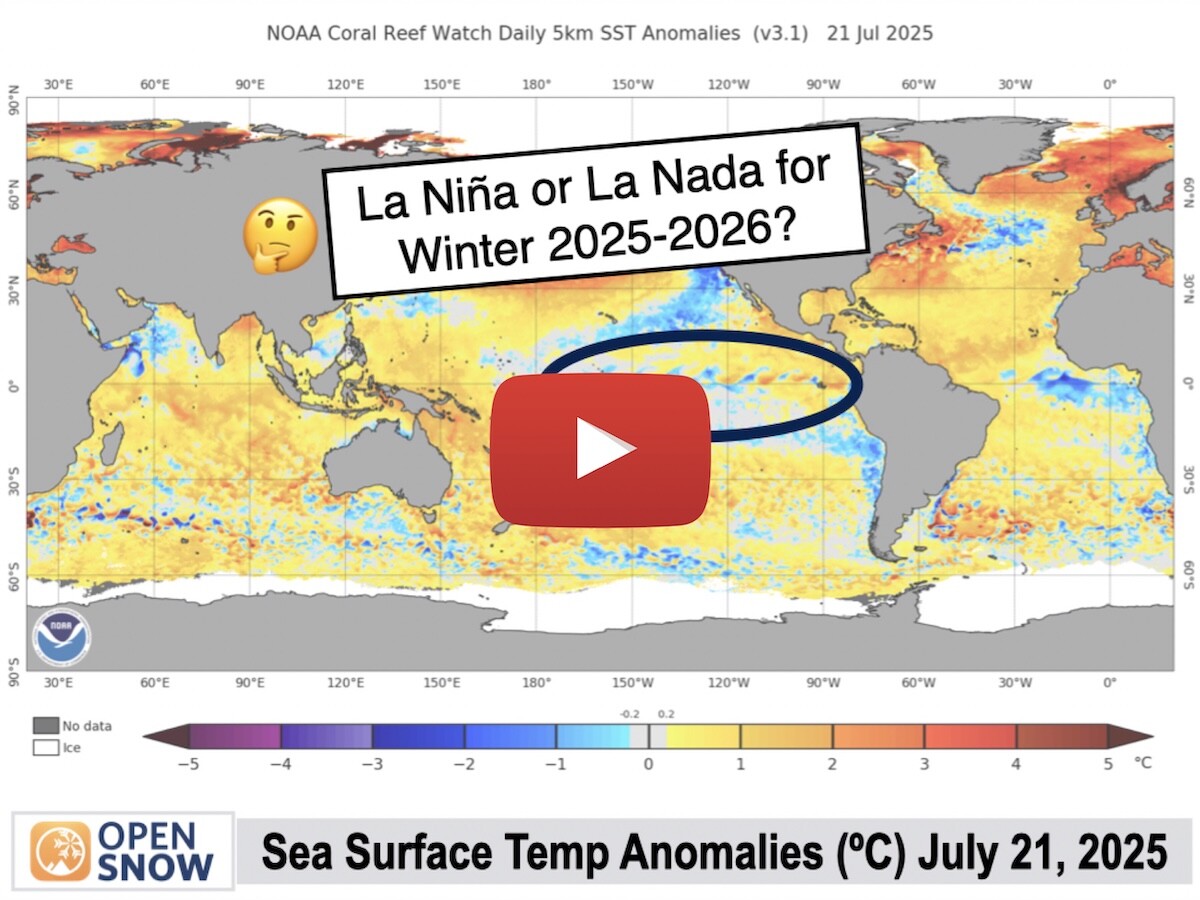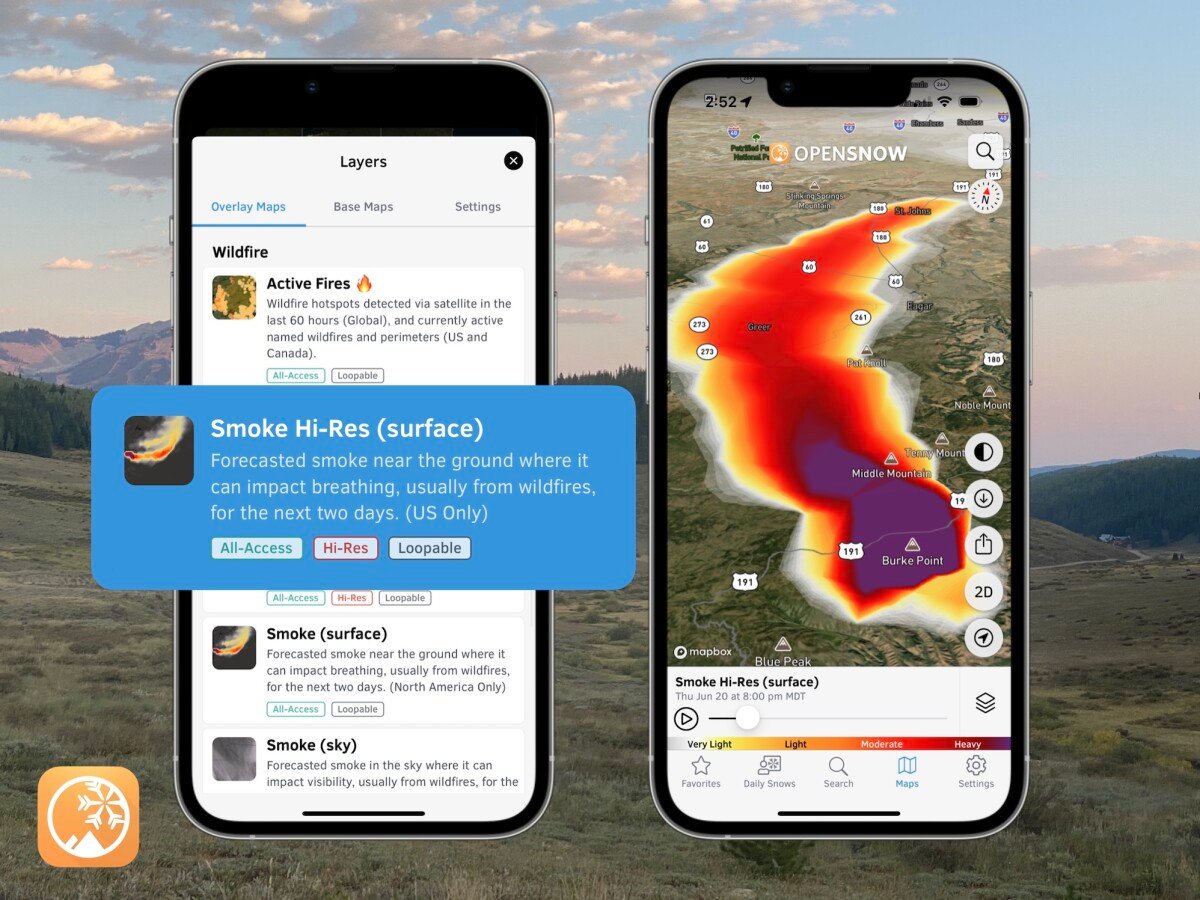Western US Daily Snow

By Alan Smith, Meteorologist Posted 2 years ago August 1, 2022
Sierra, Great Basin, and Central Rockies Monsoon Surge
Summary
A significant surge of monsoon moisture is occurring across California & the Great Basin on Monday, and this moisture will expand into Oregon, Idaho, & Wyoming on Tuesday with the potential for heavy rain and isolated flash flooding throughout these regions. The Southwest will remain in a typical daily t-storm pattern as well. Fire activity and smoke has also increased across the NW & N Rockies.
Short Term Forecast
Forecast Highlights:
- Thunderstorm activity expands into California, Nevada, Oregon, Idaho, and Wyoming this week in addition to the Southwest and Southern Rockies.
- Heavy rain and isolated flash flooding potential also expected across the above-mentioned regions with a transition from a dry thunderstorm regime to a wet thunderstorm regime across western and northern areas.
- Smoke from wildfires will impact portions of the Northwest and Northern Rockies throughout the week due to a recent uptick in fire activity.
- Cooling trend to occur across the Pacific Northwest following an unusually long-duration heatwave.
Synopsis:
An active and persistent monsoon has resulted in abundant rainfall along with areas of flash flooding across the Southwest U.S. in recent weeks. The big change over the upcoming week will feature signficant amounts of monsoonal moisture expanding outside of the "core" monsoon region into California, Oregon, the Great Basin, and portions of the Northern/Central Rockies including Idaho and Wyoming.
A shortwave trough – which is essentially a mini-trough that is more subtle on weather maps – is moving into the Great Basin on Monday and will reach Idaho/Wyoming on Tuesday. This feature will interact with increasing monsoonal moisture to result in an uptick in thunderstorm activity with the potential for locally heavy rainfall over the coming days.

Monsoon Update:
Anomalously high moisture levels associated with a monsoonal moisture surge will be found across California, Nevada, Oregon, and Utah through Monday afternoon with an uptick in showers and thunderstorms occurring or expected across these areas on Monday afternoon and evening.
The amount of water vapor in the atmosphere will be more than 200% of average across much of this region, and in Nevada, water vapor levels will approach 300% of average and will be near historical peaks. This will result in an increased threat of flash flooding to occur under stronger thunderstorms or "training" of thunderstorms (when storms re-develop and track over the same areas).

Flash Flood Watches are in effect for a large portion of the Southern California Mountains, Southern Sierra Nevada Range, Nevada Great Basin, and the Wasatch, Uinta, and La Sal Ranges in Utah. Portions of Colorado and New Mexico are also under Flash Flood Watches, mainly for burn scar flooding.
Remember, a Flash Flood Watch indicates that conditions are favorable for flash flooding to occur and cover a longer period of time and larger geographic area, whereas a Flash Flood Warning indicates that flash flooding is imminent or occurring. As of this writing on Monday afternoon, there are several Flash Flood Warnings in effect.
Also, even though there are no watches or warnings in effect across the slot canyon regions of Utah and Arizona, there will still be a potential for flash flooding in these areas.

On Tuesday, anomalously high moisture levels will expand eastward with the advancing shortwave trough into Idaho and Wyoming. As moisture becomes more established across the West, areas such as Oregon, Northern California, and Idaho that experienced a higher threat for "dry" thunderstorms on Monday will see more "wet" thunderstorms on Tuesday.

NOAA's Weather Prediction Center has highlighted a large portion of the West for being under risk of excessive rainfall and isolated flash flooding on Tuesday.

On Wednesday, drier air will move into Oregon, Idaho, and Wyoming on the backside of Tuesday's shortwave trough, while moisture levels will remain elevated across the Sierra, Southwest, and Southern Rockies where locally heavy rainfall and isolated flash flooding will be possible.
Here is the 3-day rainfall projection courtesy of the European Model from Monday through Wednesday. Notice some of the higher rain amounts projected across the Southern Sierra Nevada Range, Southern Cascade Range, and Wasatch Range in Utah, as well as the Tetons/Yellowstone in Wyoming.

Lightning Outlook:
Significant lightning activity is expected across Northern California and Western Oregon on Monday, but as moisture is just becoming established, we could see quite a bit of dry thunderstorm activity across this area, unfortunately. The same is true across Central Idaho.
Lightning activity will also be significant across the Southern Sierra Nevada Range and SoCal Mountains, as well as Nevada, Utah, Western Colorado, and Northern New Mexico.

On Tuesday, lightning activity will be most widespread across Northern California/Southern Oregon (with a better chance of wetting rains) along with the Southern Sierra, Southern New Mexico/Arizona, and the Front Range of Colorado.
Across the Great Basin and Central Rockies, there will certainly be some lightning but a heavily saturated atmosphere will favor more of a heavy rainfall scenario with low to moderate lightning activity under most storms.

On Wednesday, lightning activity will decrease across northern areas but will increase across the Sierra Nevada Range, Arizona, Southwest Utah, along with much of Colorado and New Mexico. Areas east of the Divide in Wyoming will also see some thunderstorms.

Temperature Outlook:
The Northwest has endured a significant heatwave recently with Seattle breaking its all-time record for consecutive 90ºF days, and Portland breaking its all-time record for consecutive 95ºF days.
Fortunately, cooler air is working its way into the Northwest from west to east on Monday, with further cooling expected on Tuesday. So even though "red" higher than average anomalies are still showing up for this region for Monday-Tuesday, relief is expected compared to the past week.
Also, cooler than average temperatures can be expected throughout Great Basin region early this week thanks to the monsoon moisture surge, while hotter than average temperatures are expected across the Northern Rockies and east of the Divide in the Central Rockies.

On Wednesday and Thursday, more substantial cooling is expected across the Pacific Northwest with temperatures expected to be below average across Washington and Northwest Oregon. Meanwhile, California, the Great Basin, and the Central Rockies will see a warming trend relative to the beginning of the week.

On Friday, temperatures will begin to cool down again across the Great Basin region as another surge of monsoonal moisture arrives.
Fire and Smoke Outlook:
The Yosemite Fires have seen reduced fire activity recently, but otherwise, a significant uptick in fire activity occurred across the West late last week and over the weekend. Smoke has increased across a large portion of the Northwest and Northern/Central Rockies as a result.
The McKinney Fire in Nothern California started on Friday and has exploded to over 55,000 acres since that time. The Moose Fire near the Idaho/Montana border continues to produce a lot of smoke, and fires in Northwest Montana and Southern British Columbia are adding to the smoky conditions as well.

On Tuesday, many areas will see a decrease in smoke, thanks in part to the uptick in monsoonal rains along with changing wind directions as a shortwave trough moves through.

However, varying degrees of smoke are likely across a good portion of the Northwest and Northern Rockies through the end of the week, with lots of uncertainty regarding day-to-day variations in smoke.
As far as fire danger goes, the highest threat will be across Northern California and Southern Oregon on Monday due to the threat of dry thunderstorms, while Western and Central Montana will also see elevated fire weather concerns due to gusty winds and hot temperatures.
We should see a general decrease in fire weather concerns in the days to follow as monsoonal moisture becomes more well established.
Extended Forecast
Outlook for Thursday (8/4) to Sunday (8/7):
On Thursday and Friday, another surge of monsoonal moisture will occur west into the Great Basin Sierra Nevada Range and northward into Northern Utah, Wyoming, and Southwest Montana. The Four Corners states will remain in an active monsoonal pattern as well with widespread thunderstorms and wetting rains expected for a large portion of the West.
The Washington Cascades could also see some showers on Thursday (along with cooler temperatures) as a trough of low pressure arrives, before drying out again on Friday.

Over the weekend, we'll see a southward shift in monsoonal moisture with decreasing thunderstorm chances across Montana and Western Wyoming. Moisture levels will remain about the same or increase from California to Colorado with locally heavy rainfall and isolated flash flooding possible across a large portion of the Southwest. The Front Range and adjacent plains of Colorado will also see an uptick in moisture.

Outlook for Monday (8/8) to Monday (8/15):
During the second week of August, the Southwest will continue to see below average temperatures (relative to the typical scorching hot levels of course) as an active monsoon continues, while the West Coast and Northern Rockies will be favored for above average temperatures.

A very active monsoon pattern is expected to continue across the West with wetter than average conditions expected throughout the Southwest as well as the Great Basin, Sierra Nevada Range, Wyoming, and Eastern Idaho.

Thanks so much for reading! Next update on Wednesday (8/3).
ALAN SMITH
About Our Forecaster




